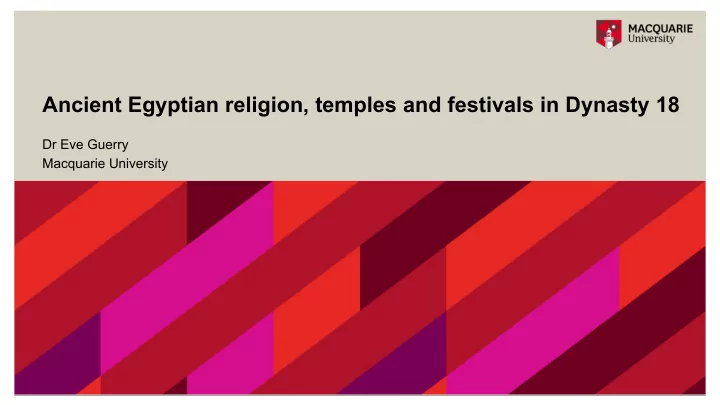

Ancient Egyptian religion, temples and festivals in Dynasty 18 Dr Eve Guerry Macquarie University
Ancient Egyptian religion, temples and festivals in Dynasty 18 SYLLABUS LINKS Ancient Egyptjan Society in the New Kingdom untjl the death of Amenhotep III • Religion • Temples • Festjvals KEY QUESTIONS • To what extent were the ordinary people involved in the religion and cult of New Kingdom Egypt? • What is the evidence for the role of religion in daily life during the 18 th Dynasty and how and why does it change during this period?
Offjcial T emple Cult htup://dlib.etc.ucla.edu/projects/Karnak/experience • State religion, theoretjcally conducted by the king • Daily temple ritual conducted by priests on behalf of the king • Restricted access inside the temple What involvement did ordinary people have in Dynasty 18 religion and cult?
Great Temple of Amun at Karnak
Digital Karnak University of California, Los Angeles (UCLA) htup://dlib.etc.ucla.edu/projects/Karnak/experience
Great Temple of Amun at Karnak Vertjcal aerial view Oblique aerial view S. R. Koehler, Architecture, Sculpture, and the Industrial Arts Plan Among the Natjons of Antjquity Renfrew & Bahn (2012:79) (Boston, 1879), pl.1, fjg. 9.
T emple entrance
Courtyard
Hypostle hall and Colonnaded hall
Sanctua ry
Processional Way
Egyptian religion during Dynasty 18 Growing evidence of a direct relatjonship between gods and ordinary people. EVIDENCE: • Festjval processions • Oracles • Votjve ofgerings
Opet festival From the temple of Horus at Edfu (Greco-Roman Period) From Hatshepsut’s chapel in Karnak (Dynasty 18)
Opet festival • Kingship rite, connectjng the king with his divine father, Amun. • The power and legitjmacy of kingship are ritually bequeathed by Amun to his son, the living Horus. • Belongs to offjcial royal ideology and involved the personal appearance of the king. • First appears in Dynasty 18. • Centrality of the procession involved the people.
Processional Way
Processional Way • Public vs. private aspect of the temple Opet cult Festjval • Public celebratjon Procession during the festjval procession route • Begins in Dynasty 18 Kemp (1991: fjg.71, p.203)
Oracles • Individuals could consult the god during festjval processions EVIDENCE Ostraca with oracle questjons “Was it he who stole the mat?” “Will Setj be appointed as priest?”
Votive Ofgerings • Individuals could have a direct relatjonship with the god EVIDENCE Theban ostraca dedicated to Amun Cairo ostracon 12217: “Because your strength is greater than that of any god, I have placed you in my heart. With you as my protector I will not fear”.
Shrine of the “hearing ear” at Karnak temple
UCLA Reconstructjon of the “Shrine of the hearing ear” of “Shrine of the hearing ear” of Thutmose III, Thutmose III, Temple of Amun at Karnak Temple of Amun at Karnak htup://dlib.etc.ucla.edu/projects/Karnak/experience
Amulet of a votjve ear Dynasty 18, Deir el-Bahari Boston, Museum of Fine Arts, no.06.2466. <htup://www.mfa.org/collectjons/object/amulet-of-a-votjve-ear-136179>
Amarna Period • King is the only connectjon to the god EVIDENCE Hymn to Aten “You are in my heart, there is no other who knows you, only your son, Akhenaten, whom you have taught your ways and your might.” • King is the focal point of personal devotjon EVIDENCE King replaces gods in - Household shrines - Tomb depictjons Household shrine from Amarna. - Festjval processions Ägyptjsches Museum Berlin, stele no. 14145
Recommend
More recommend